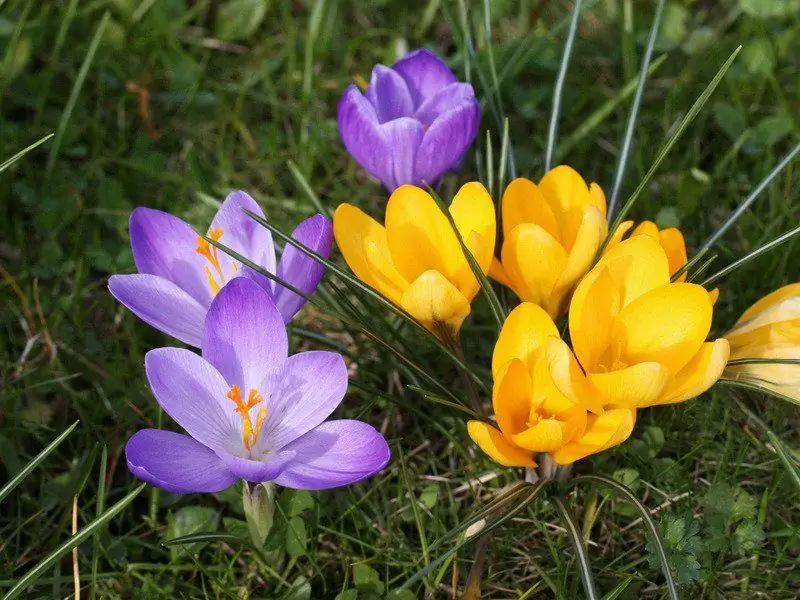
Table of contents:
- Author Bailey Albertson [email protected].
- Public 2023-12-17 12:53.
- Last modified 2025-06-01 07:32.
Spring bulbous flowers: a selection of winter-hardy and unpretentious
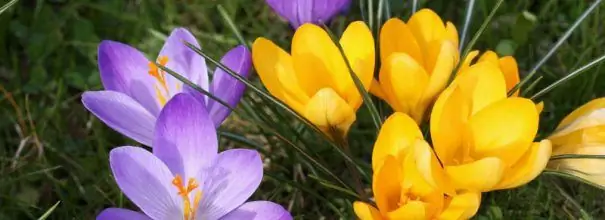
Spring flowering of bulbous perennials begins very early, the first crocuses and woodlands bloom in sunny places before the snow completely melts in the shady corners of the garden. These unpretentious plants can delight the owner with their flowering for many years without requiring special care.
Content
-
1 Popular and unpretentious types of spring bulb flowers
- 1.1 Crocuses
-
1.2 Proleski
- 1.2.1 Double-leaved screech
- 1.2.2 Siberian beetle
- 1.3 Tulips
- 1.4 Daffodils
- 1.5 Muscari (mouse hyacinth)
- 1.6 Kandyk
- 2 General features of growing bulbous plants
Popular and unpretentious types of spring bulb flowers
Among bulbous perennials there are hardy frost-resistant species that winter without shelter in the conditions of central Russia and do not cause much trouble for the gardener.
For many years, in my garden near Kazan, crocuses of several varieties, Siberian redwood, muscari, various varieties of tulips and daffodils have been growing beautifully. All of them delight me every spring with their colorful flowering. I do not cover them with anything for the winter, but I dig them out only when it is necessary to transplant to another place. The soil in my garden is sandy, abundantly flavored with organic matter over the long decades of the garden's existence, and the site itself is located on a hill and is well warmed by the sun in spring.
Crocuses
Crocuses bloom on the first thawed patches in mid-April and end their flowering at the very beginning of May. First, buds appear directly from the ground, the height of plants during flowering does not exceed 10-15 cm. Crocus flowers are yellow, white, lilac, striped. A few days after the beginning of flowering, very narrow light green leaves with a longitudinal white stripe in the center begin to grow, after flowering they grow up to 15-20 cm in height and completely dry out by mid-June. Dig up and divide the nests of corms every 3-5 years. Crocuses cannot stand dampness, they need good sunlight and loose sandy or sandy loam soil. North of Moscow, it is advisable to cover them with fallen leaves for the winter.

Crocus flowers are yellow, white, lilac, striped
Proleski
Redwoods bloom in April and bloom until the second half of May. The flowers are blue-blue, white or pale pink. Narrow bright green leaves appear simultaneously with buds and die off at the end of June. Spruce trees grow well and bloom profusely in the sun and in the shade on any soil, requiring no maintenance, forming many children and often self-seeding in the most unexpected corners of the garden. Without transplanting, they can grow for decades, forming solid carpets of flowers. If desired, the overgrown curtains can be divided after 3-4 years.
Double-leaved scrub
Double-leaved scrub - the earliest and stunted, plant height does not exceed 10-15 cm. Its wide-open stellate flowers are directed upwards.
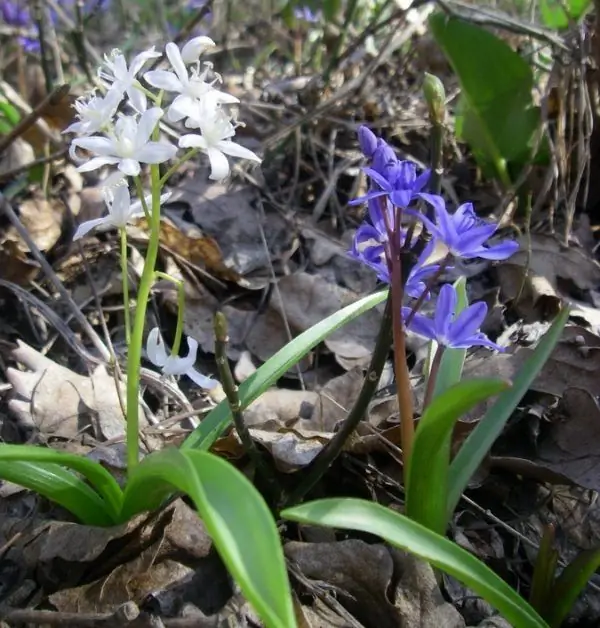
Double-leaved screech - the earliest and shortest
Siberian Proleska
Siberian beetle is the most hardy and frost-resistant. It grows up to 15-20 cm in height, drooping stellate-bell-shaped flowers are directed downward.

Siberian scrub - the most hardy and frost-resistant
Tulips
The height of tulips, depending on the variety, reaches from 20-30 to 50-70 cm, flowering lasts from early May in the earliest varieties to early June in the latest ones. The flowers are red, pink, burgundy, white, yellow. Broad bluish-green leaves grow earlier than peduncles and dry up by mid-summer. For good growth and flowering, tulips need sunny areas with loose, fertile soil. They are drought-resistant and do not like dampness.
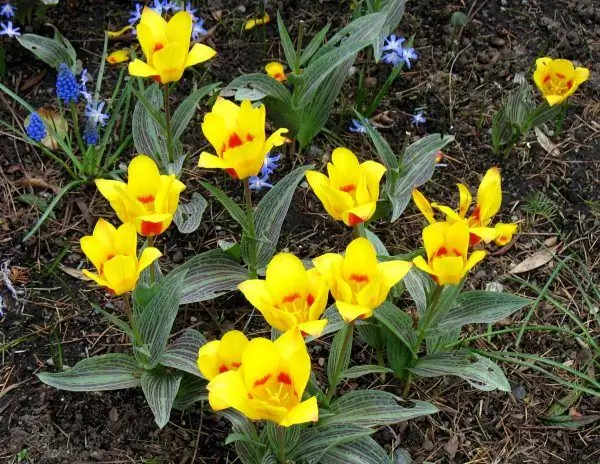
The early dwarf Greig tulip from the botanical tulip group has bright flowers and showy striped leaves
The most winter-hardy and hardy groups of varieties are botanical, Darwin's hybrids, simple early and simple late, they can grow in one place without transplanting for up to 5-7 years and hibernate without shelter even in northern regions
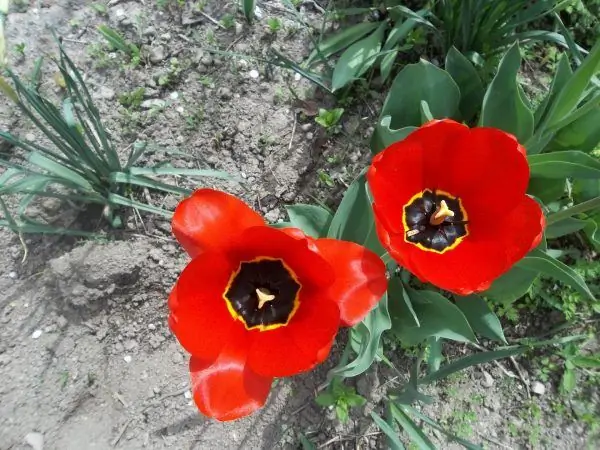
Large, bright and tall tulips from the group of Darwin hybrids in the middle lane bloom on the May holidays
Daffodils
Daffodils grow up to 35-40 cm in height, different varieties bloom from early May to early June. The color of the flowers is white, yellow, orange in different combinations. The narrow green leaves come out of the ground before the peduncles and die off by the middle of summer. Daffodils bloom well in sunny and slightly shaded areas, they need fertile sandy loam or loamy soil. In dry weather, weekly watering is desirable until the leaves begin to turn yellow. A transplant is recommended after 4-5 years, clumps over 7-8 years old almost stop blooming.
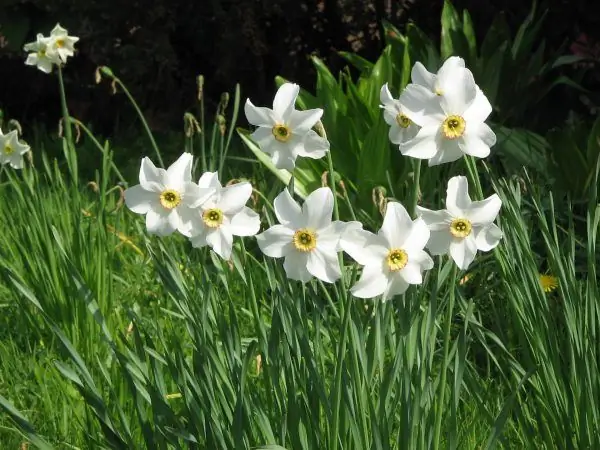
Poetic daffodils are very unpretentious and winter-hardy
The most winter-hardy and hardy groups of varieties are poetic and small-crowned, they hibernate without shelter even in the northern regions
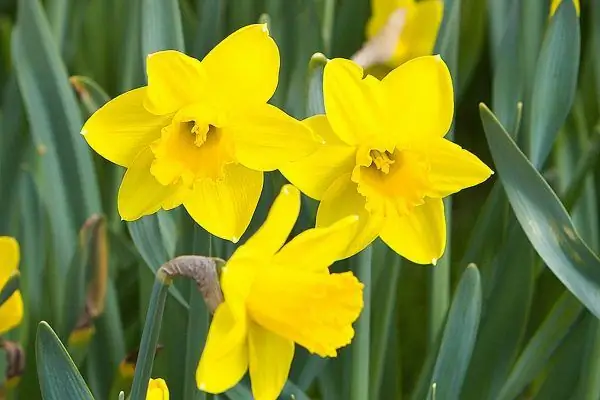
Among the tubular daffodils there are very early varieties with large yellow flowers.
Muscari (mouse hyacinth)
Mouse hyacinths, depending on the variety, reach a height of 10-30 cm. They bloom in early May and bloom for a month. Blue-violet, blue-blue or white muscari flowers are collected in dense vertical brushes. The narrow bluish-green leaves grow simultaneously with the buds and die off by July. In late August - early September, re-growth of leaves often occurs, this is normal and does not interfere with a successful wintering.
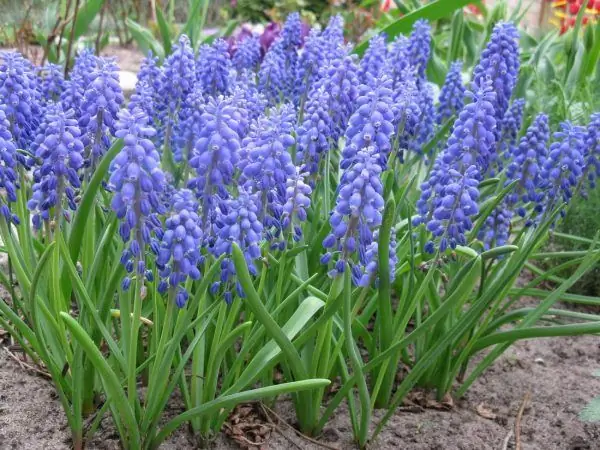
Mouse hyacinths are undemanding to the soil, winter-hardy and drought-resistant
Muscari bloom very abundantly in open, sunny places. They also withstand light shading, but flowering will be weaker. A lot of children are formed, it is recommended to plant the curtains after 4-6 years, but on fertile soil they can grow without transplanting for 10 years or more, without reducing the flowering intensity. Mouse hyacinths are undemanding to soil, winter-hardy and drought-resistant.
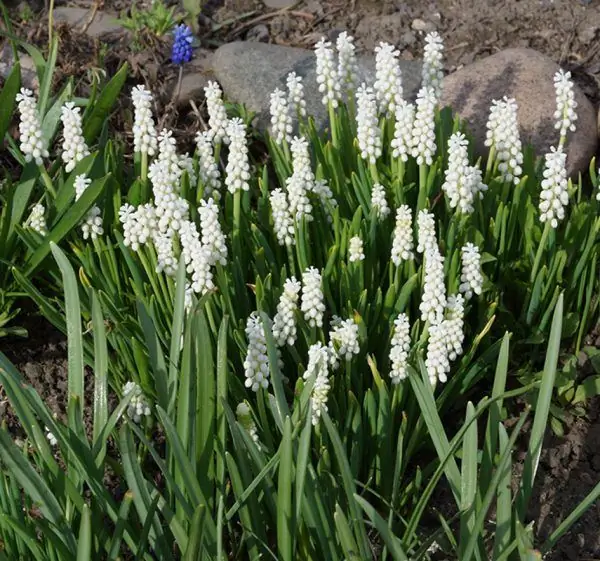
The flowers of mouse hyacinths are blue or white.
Kandyk
Kandyk is a very frost-resistant plant 15-35 cm high, overwintering without shelter even in Siberia. The flowers are lilac, pink, white or yellow, with petals wide open or bent back. Kandyk blooms in April on the first thawed patches and blooms for 2-3 weeks. Beautiful wide leaves with a speckled pattern appear simultaneously with the flowers and die off in early summer. Kandyk requires a shady or semi-shady location and slightly acidic permeable soil with good drainage; in hot dry summers it needs weekly watering even after the leaves die off. He does not like transplants, you should not disturb the plants more often than once every 5-7 years.
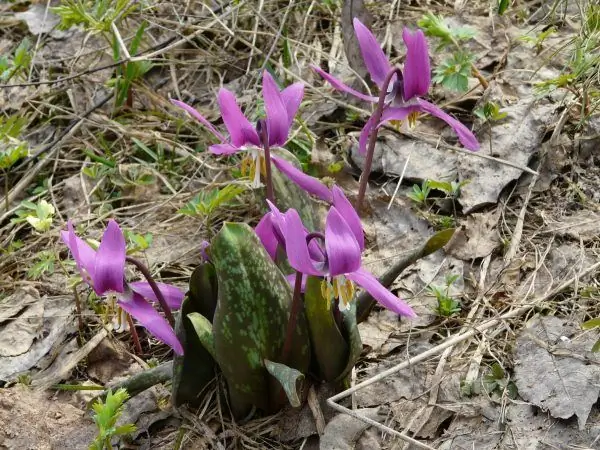
The moisture-loving kandyk grows well in the shade and is not afraid of Siberian frosts
General features of growing bulbous plants
For the whole variety of bulbous perennials, there are several general rules for planting and growing them:
- Soon after flowering, the leaves of the bulbous flowers turn yellow and die off. Yellowed leaves look unsightly, but they cannot be cut off until they are completely dry, so as not to weaken the bulbs. Therefore, in flower beds, bulbous plants are planted in small groups among spreading perennials with lush foliage. Peonies, daylilies, hosts, astilbe, ferns will be good camouflaging neighbors for them.
- Over the years, the plantings thicken due to the formation of a large number of small daughter baby bulbs. If at the same time flowering weakens, such a curtain should be dug out after the leaves have completely dried and planted.
- All bulbous plants are afraid of stagnant water and prefer elevated places. When planting on heavy clay soil, a drainage device is necessary; for this, it is enough to pour river sand on the bottom of the planting grooves with a layer of 3-5 cm.
- It is necessary to plant spring bulbous perennials in the fall: in the south - in October, in the middle lane - in September and early October, in the northern regions, in the Urals and Siberia - from mid-August to mid-September.
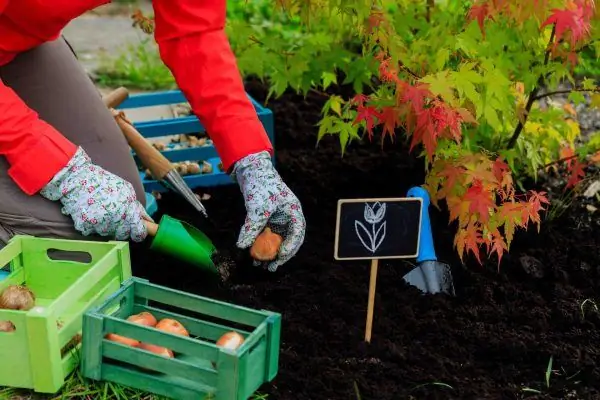
Spring flowering bulbous plants are planted in autumn
- Planting depth is equal to three times the height of the bulb. In this case, the depth means the distance to the soil surface from the top of the bulb, and not from its bottom with roots.
- The acidity of the soil for all bulbous plants, except for the kandyk, should be close to neutral. Too acidic soils are limed one year before planting the bulbs.
- Bird droppings and fresh manure are contraindicated in bulbous flowers. The best fertilizers for them are leafy humus and completely decomposed compost.
The bright flowers of spring bulbous perennials greatly adorn the garden at the beginning of the summer season. These plants are unpretentious and, if properly planted, can grow in one place for years with almost no maintenance.
Recommended:
Wild Forest Cat: Photos, Species And Names, Nature And Lifestyle, Breeding Cats
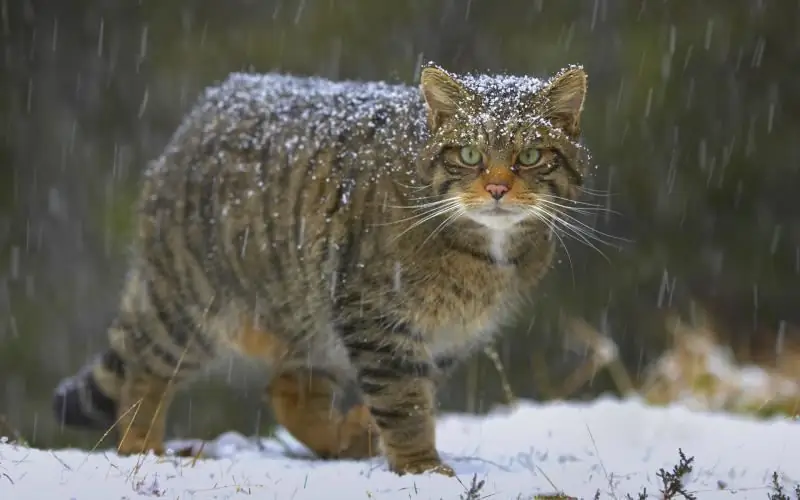
External features of a wild forest cat. The distribution area of the animal. The nature and habits of the predator. Reproduction issues. Wild forest cat in captivity. Reviews
Ornamental Shrubs Blooming In Spring: An Overview With Names And Photos
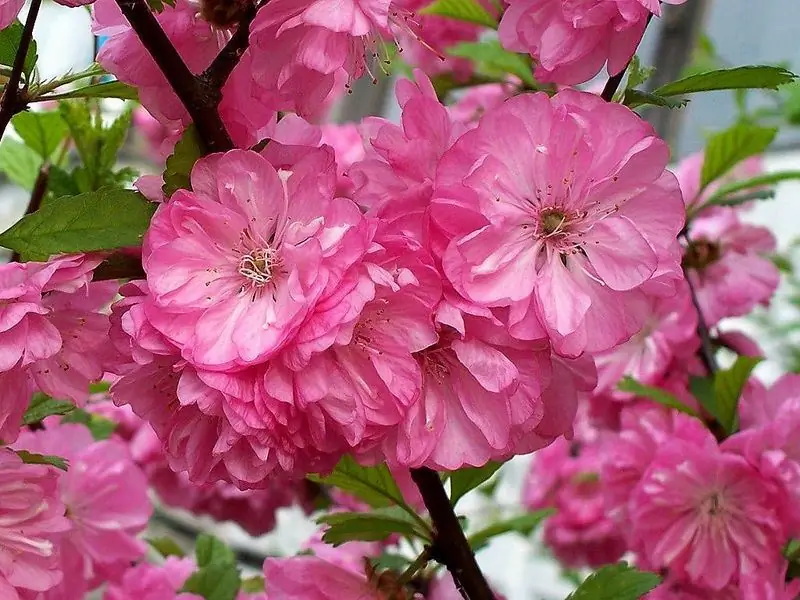
A selection of popular types of ornamental garden shrubs blooming in spring: photos, brief descriptions
Planting Roses In Spring: When And How To Plant Flowers
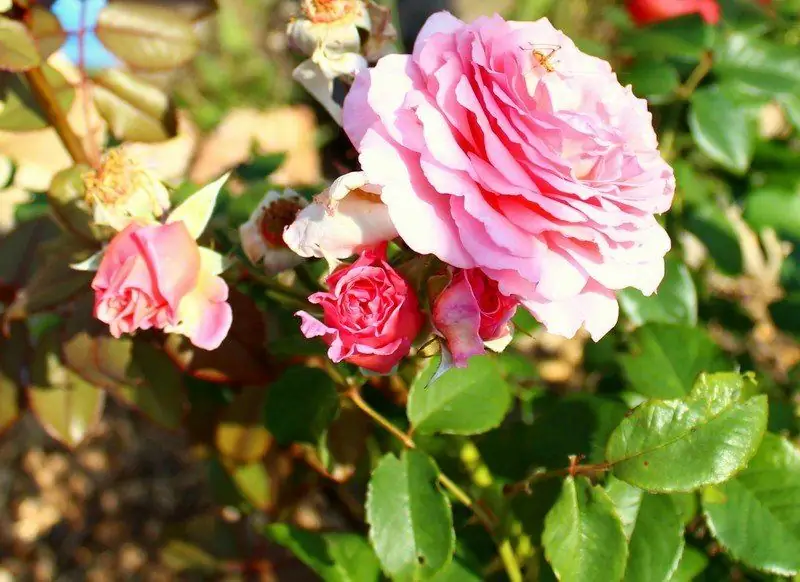
How to properly prepare seedlings and plant roses in the spring, step by step instructions, the best terms for different regions
Unpretentious Annual Flowers For A Summer Residence: Names And Photos, Including Blooming All Summer
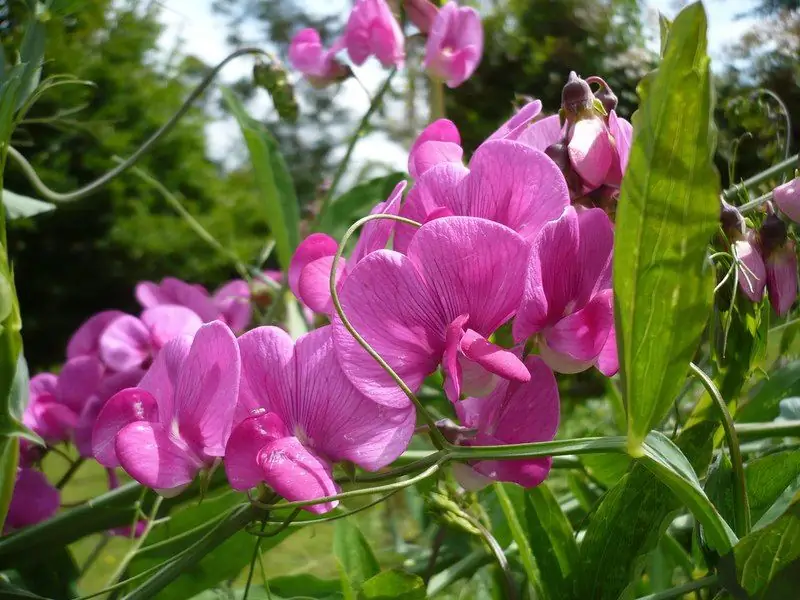
A selection with photos and short descriptions of beautiful and unpretentious annual flowers for novice florists
Indoor Orchids: Types, Photos And Names
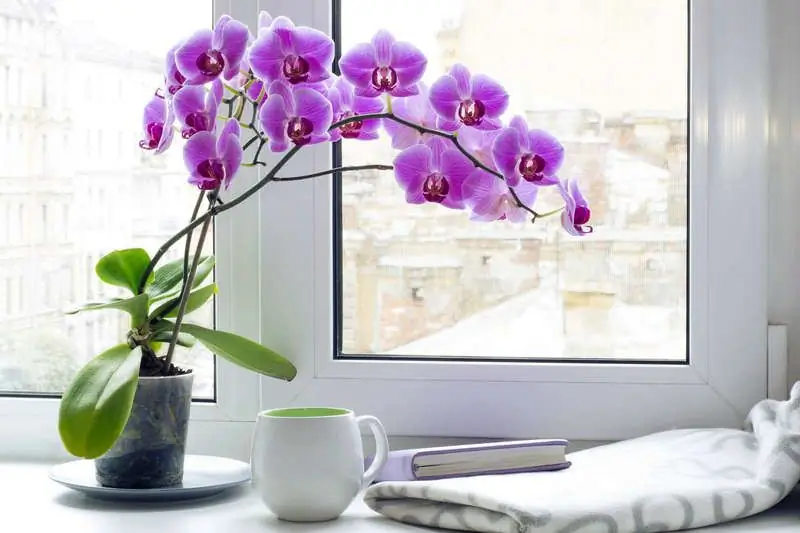
A selection of popular types of indoor orchids: photos and short descriptions, the level of complexity of care
